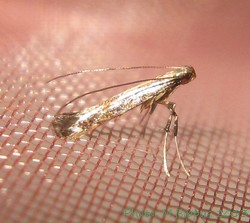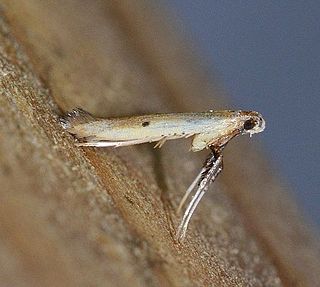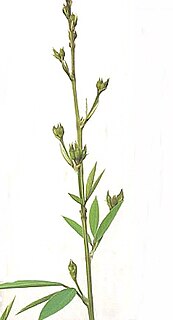
The genus Cajanus is a member of the plant family Fabaceae. There are 37 species, mainly distributed across Africa, Asia and Australasia.

Gracillariidae is an important family of insects in the order Lepidoptera and the principal family of leaf miners that includes several economic, horticultural or recently invasive pest species such as the horse-chestnut leaf miner, Cameraria ohridella.
The Cajanus family is an ancient Finnish clerical family that has produced numerous clergymen, government officials, and academics. Count Per Brahe nominated the progenitor of the family, a local nimismies Anders Eriksson (Hjerta), to serve as bailiff of his fiefdom of Kajaani. His sons became pastors in neighbouring parishes and the family assumed a Latinate surname derived from the name of the town of Kajaani.

Daniel Cajanus was a Finnish giant. He made his living by exhibiting himself for money; he appeared in many European countries and attracted the interest of scientists and laypeople, including royalty. After his death, portions of his skeleton found their way into museums, where some parts still remain.
Phytophthora cajani is a species of water mould that infects pigeon pea. It was first described in 1978.
Adisura marginalis is a species of moth of the family Noctuidae. It is found in Myanmar, India, Malaysia, the Philippines, Thailand, Vietnam and Indonesia, as well as the Northern Territory, Queensland and Western Australia in Australia.

Phodoryctis caerulea is a moth of the family Gracillariidae. It is known from India, Malaysia (Sabah), Indonesia (Java), Sri Lanka, Fiji, Guam, the Solomon Islands, Japan and Taiwan, as well as Tanzania.
Caloptilia prosticta is a moth of the family Gracillariidae. It is known from Madagascar, Nigeria, the Seychelles, South Africa and Sri Lanka.
Caloptilia soyella is a moth of the family Gracillariidae. It is known from Cape Verde, China, Fiji, India, Indonesia (Java), Japan, Sri Lanka and Vietnam.
Porphyrosela neodoxa is a moth of the family Gracillariidae. It is known from Bihar, India.
Liocrobyla paraschista is a moth of the family Gracillariidae. It is known from Fiji, India and Japan and Korea.
Epicephala vermiformis is a moth of the family Gracillariidae. It is known from Java, Indonesia.
Caloptilia acrotherma is a moth of the family Gracillariidae. It is known from Indonesia (Java) and Sri Lanka.

Caloptilia violacella is a moth of the family Gracillariidae. It is known from Illinois, Missouri, Florida, Georgia, Kentucky, Maine, Maryland, New York and Texas in the United States.
Caloptilia callicirrha is a moth of the family Gracillariidae. It is known from Fiji, Guadalcanal and Rennell Island.
Caloptilia sphenocrossa is a moth of the family Gracillariidae. It is known from Java, Indonesia and Pahang, Malaysia.

Gracillariinae are a subfamily of moths which was described by Henry Tibbats Stainton in 1854.

Cajanus scarabaeoides is a flowering plant in the genus Cajanus. Of the 32 different species within the genus Cajanus, only one, C. cajan (pigeonpea), is cultivated. Cajanus scarabaeoides is the closest wild relative to C. cajan, and is one of the easiest wild species to cross with pigeonpea cultivars. C. scarabaeoides is found naturally in both temperate and tropical zones around the globe. This species has higher levels of drought tolerance, is found to have greater protein content, and has higher levels of resistance to insect pests compared to cultivated types. These genetic traits can be crossed with C. cajan to improve the crop's productivity. For subsistence farmers, this can reduce economic losses and drastically improve overall crop yield.
Cajanus kerstingii is a widely ignored shrub found mostly in open savannah conditions across western Africa. It is closely related to the widely utilised Cajanus cajan, otherwise known as pigeon pea. Cajanus kerstingii can be consumed by humans as a cereal, pulse, fibre or forage. Unfortunately, very little data exists for this plant, but "one may reasonably expect it to be of value".

The pigeon pea, also known as arhar, tur, red gram, or gungo peas in Jamaica is a perennial legume from the family Fabaceae. Since its domestication in the Indian subcontinent at least 3,500 years ago, its seeds have become a common food in Asia, Africa, and Latin America. It is consumed on a large scale in South Asia and is a major source of protein for the population of the Indian subcontinent. It is the primary accompaniment to rice or roti and has the status of staple food throughout the length and breadth of India.







